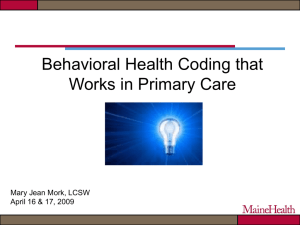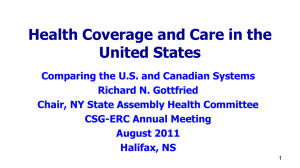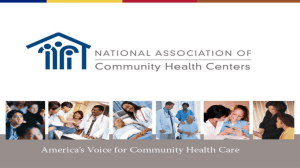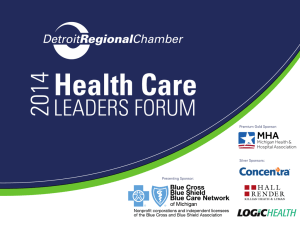The Affordable Care Act—What Health Care Reform Means for
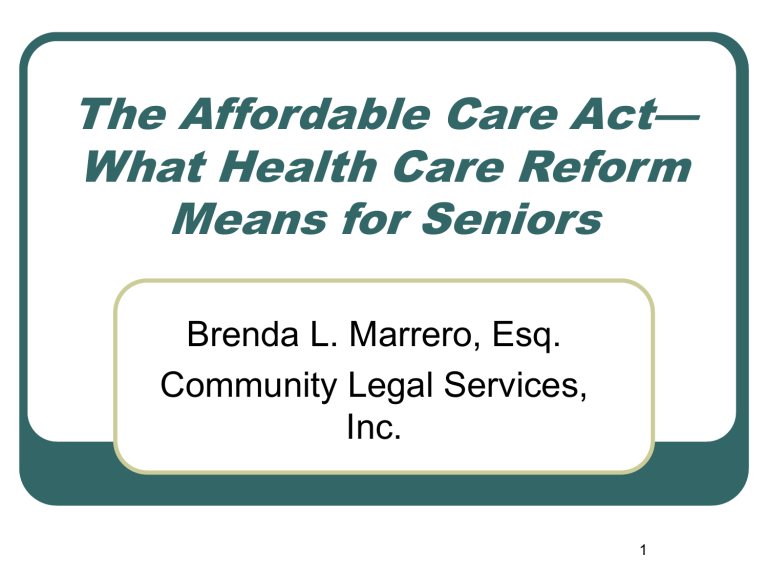
The Affordable Care Act—
What Health Care Reform
Means for Seniors
Brenda L. Marrero, Esq.
Community Legal Services,
Inc.
1
Community Legal Services, Inc.
We are a non-profit public interest legal agency providing free legal services to low income
Philadelphians
We have 2 offices: Center City (15 th &
Chestnut) and Broad and Erie
Aging and Disability Unit: @ Broad and Erie.
We represent low income seniors in areas like
Medicare, Medicaid, long term care, nursing home law, and Social Security/SSI matters
2
Debunking myths
The Affordable Care Act (ACA) does
NOT cut Medicare benefits
Medicare’s guaranteed benefits remain intact
3
Changes to Medicare
Open Enrollment Period is eliminated — starting in 2011 an individual who enrolls in a Medicare Advantage (MA) Plan may return to original Medicare
(red/white/blue card) and a Part D Plan during the first 45 days of the year
Annual Enrollment Period is now
October 15 thru December 7 —this took effect January 2011
4
Medicare Cost Sharing improved
Starting in January 2011 there will be no coinsurance or deductibles for traditional
Medicare preventive services
Medicare will cover free annual comprehensive wellness visit, and personalized prevention plan
Smoking cessation and counseling services are free
5
Medicare Advantage Plans-
Changes and Improvements
Starting January 2011 MA Plans cannot impose cost-sharing for chemotherapy, renal dialysis services or skilled nursing care services that exceed the costsharing for those services under original
Medicare —so whether you are in MA
Plan or Traditional Medicare, your cost share will be the same
6
MA Plans Con’t
Starting in 2014, 85% of MA Plan revenues must go towards benefits, NOT profits, or plans may and will be subject to sanctions
Goal: to improve quality of care and to avoid MA Plans from being paid more for the same services as offered under
Traditional Medicare
7
Elimination of Exclusion of Coverage of Certain Part D Drugs
Starting in 2014 Medicaid can no longer exclude smoking cessation drugs, barbiturates and benzodiazepines.
Because Part D covered drugs are defined generally as those drugs covered under Medicaid, this ACA provision results in a small expansion of
Part D coverage of barbiturates.
8
Con’t: Part D Drugs
Starting in 2013 Part D will cover benzodiazepines and will cover barbiturates used in the treatment of epilepsy, cancer of a chronic mental disorder
9
Part D and Closing the Donut
Hole
The ACA creates a multi-part process for closing the Part D coverage gap, or
“donut hole”
Starting in 2011 the coverage gap will decrease each year until 2020 when it will be eliminated and then beneficiaries will pay 25% co-insurance for prescriptions
10
How the donut hole will be eliminated
Starting in 2011:
•
Gradually phasing down the amount beneficiaries pay for generic drugs
•
Drug manufacturers must offer a 50% discount on brand name drugs filled when you are in the donut hole
Phasing down cost-sharing for brand name drugs starts in 2013
Reducing the out of pocket amount needed to reach “catastrophic coverage” from 2014-2019
11
Improvements to Medicare appeals
For exceptions and appeals filed on or after January 1, 2010, Rx drug plan sponsors have to use a single, uniform exceptions and appeals process and provide access to that process through a toll-free telephone number and an
Internet website
12
Improvements to Medicare complaint system
Required to develop an easy to use complaint system that will allow for collection and maintenance of complaints received through and by
Prescription Drug Plan (PDPs) and
Medicare Advantage-Prescription Drug
(MA-PD) Plans
13
Low-Income Medicare beneficiaries
There are ACA Provisions related to low income Medicare beneficiaries that will help with cost sharing
14
LIS & Special Rule for Widows and Widowers
Effective January 1, 2011 an individual whose spouse dies in the middle of a low-income subsidy eligibility period is granted continued eligibility for a full year beyond the date when his/her eligibility would normally cease to be effective
15
Eliminate Cost Share for Certain
Duals
Effective no earlier than January 1,
2012, the ACA eliminates cost sharing for Part D drugs for all full benefit dual eligibles (MA and Medicare) who are receiving home and community based services
•
This creates equity b/w those receiving care in an institution (i.e. nursing home) and those receiving the same care in the community
16
Funding Outreach/Assistance
Extends and increases the amount of additional funding (that was included in MIPPA law in 2008) for State Health Insurance
Counseling Programs (SHIPs), Area Agencies on Aging (AAA) and Aging and Disability
Resource Centers (ADRCs)
•
ACA increases funding to $15 million for SHIPs and
AAAs, and $10 million for ADRC’s for FY 2010-FY
2012
17
Medicaid Provisions
The ACA gives states the option as of January
2010 to expand coverage to childless adults, except for those with Medicare Part A and/or
Part B, with incomes up to 133% of FPL
Beginning in January 2014 states will be required to cover these individuals
This is helpful for those who have to wait 2 years after their social security disability benefits begin before being entitled to
Medicare coverage
18
ACA Long Term Care Provisions:
Some Highlights
Community First Choice Option
Money Follows The Person
Spousal Impoverishment Protections for
HCBS Recipients
19
Community First Choice (CFC)
Option
This is a provision of the ACA that provides the States with a financial incentive to make a new Medicaid benefit available to individuals who have a need for personal attendant services
20
CFC Benefits
Help with ADLs, IADLs, and health related tasks
Services must be provided per care plan with significant consumer participation in a home or community setting
Optional: Transition services (NH to community). Funding can be used to pay for rent and utility deposits, 1 st month’s rent and utilities, bedding, basic kitchen supplies and other necessities
21
Eligibility for CFC Option
Income limit up to 150% of FPL (or 300% of SSI limit, which would be PA and that limit is $2022 per/mo)
Must be “nursing facility clinically eligible” (NFCE)
Spouse’s income can be deemed available! This is different from typical
HCBS waiver
22
Money Follows The Person
Grants to states to fund HCBS for
Medicaid recipients transitioning out of nursing homes (the Medicaid $ follows the person out of the facility)
Under the ACA the amount of time a person had to have been in a nursing home is reduced to 90 days (v. 180)
23
Spousal Impoverishment
Protection
Spousal Impoverishment: income and resource counting rules which protect recipient’s spouse from being impoverished by spouse’s long term care costs
Currently these rules only apply to nursing facility residents
ACA provision would requires States to extend this protection to spouses of recipients of
HCBS services
24
Health Care Reform and PA
Unclear what if any implementation may occur under Corbett
Secretary of DPW Gary Alexander may consider a Medicaid block grant —bad idea for low income seniors —see handout
Budget challenges present risk to implementation of Medicaid expansion
25
Medicaid cuts in PA—how they affect seniors
Current budget cut proposals include:
•
Eliminating coverage for dentures for
Medicaid recipients —Medicare already does not cover this
•
Limiting prescriptions to 6 per month
•
Eliminating funding for Human Services
Development Fund entirely —will affect senior centers and Meals on Wheels
26
How you can get involved
Write to your state senators and representatives! Voice your opposition to the state Medicaid funding cuts that will harm seniors’ health
Write to your senators and representatives voicing your support for the ACA and its improvements to
Medicare and long term care
27
Resources
Community Legal Services, Aging &
Disability Unit: 215-227-2400
National Senior Citizens Law Center, www.nsclc.org
Kaiser Family Foundation, www.kff.org
Center for Medicare Advocacy, Inc., www.medicareadvocacy.org
28



